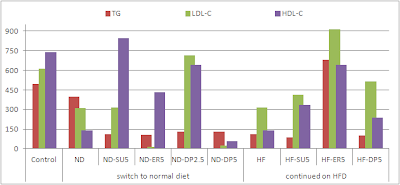Fructose Epimer D-Psicose Could Be First Sweetener to Actively Promote Weight Loss: Reduced Weight Gain and Direct Inhibitory Effect on Adipocyte Maturation in Rodent + Reduced Postprandial Glucose & Insulin in Human Trial
 |
| Image 1: No, just a few grams of d-psicose won't turn these into a "health food", but it could help ameliorate the "damage" |
The first sweetener that will actively help in weight loss?
In the course of a 12-week trial, a group of Sprague-dawley rats was initially fed up with the standard laboratory "high fat diet" that is essentially an identical twin of the standard American diet with 15.1% of the energy from protein, 38.8% from fats and 47.1% from carbohydrates. After four weeks the rodents were assigned to different groups, which were either switched over to a standard diet (14.7% protein, 9.4% fat, 76.9% carbohydrates) or were maintained on the energy-dense high fat diet. Each of the study arms had another 5 sub-groups the animals in which received, either
- normal (ND) or high fat (HF) diet without supplement (control),
- ND or HF + 5% sucrose (SU-5),
- ND or HF + 5% erythritol (ES-5),
- ND or HF + 2.5% d-psicose (DP-2.5), or
- ND or HF + 5% d-psicose (DP-5)
 |
| Figure 1: Change in body weight, total food intake and feed efficiency (right axis) in the 2nd half of the study (data adapted from Chung. 2012) |
Could d-psicose be an ideal adjunct to your weight loss regimen?
In this context, it is important to note that the previously fattened rodents were already 23% "overweight". In other words, while the rodents on the normal diet kept gaining weight at a rate of 2.4-2.7g per day, the weight gain of the "fat" rodents in the ND-DP5 group was so profoundly ameliorated that they ended up at the same "normal" weight at the end of the study as the intially non-obese rodents on the standard diet. And even without the dietary switch, the addition of 5% d-psicose led to a profound (-50%) reduction in diet induced weight gain in the high fat group.
 |
| Figure 2: Total white adipose tissue (right axis, in g), epididymal, perirenal and retroperitoneal visceral fat (in g) in the different groups at the end of the post-fattening 52-day feeding period (data adapted from Chung. 2012) |
Lose weight, lose fat, but what about your liver?
Yet despite the fact the combined "weight loss effect" of the "normal" (=low fat) diet with supplemental d-psicose is thusly fundamentally different and unquestionably way more desirable than the "Half as Heavy, Twice as Fat" effect of the Atkins diet (cf. news from last Friday), the structural kinship of d-psicose and fructose raises the question if the former did induce similarly detrimental health effect on the liver as its notoriously sweet cousin.
 |
| Figure 3: Light image of liver tissue sections from ND, ND-SUS and ND-DP-5 groups (adapted from Chung. 2012) |
Our results [...] showed that ND-DP group tended to induce liver enlargement suggesting increased glycogen deposition in liver as extra-energy storage of d-psicose. However, HF-DP group did not show any difference compared to HF group. It is possible that HF diets containing relatively low carbohydrates [...] induced lower liver glycogen level masking the effects of d-psicose.Moreover, previous long-term studies (12-18 months) by Yagi & Matsuo did not reveal any adverse side-effects in relation to the d-psicose induced increase in liver weight (Yagi. 2009).
 |
| Figure 4: Lipid profiles (triglycerides, LDL-C and HDL-C) at the end of the study period (data adapted from Chung. 2012) |
Bottom line: Promising, but more than one human study would be nice
 |
| Image 2: Sponge cakes made without addition, with fructose or with d-psicose (img courtesy of the Kagawa Industry Support Foundation) |


